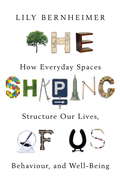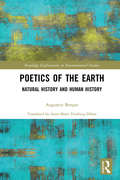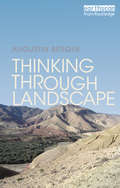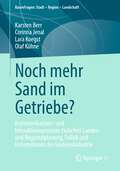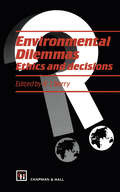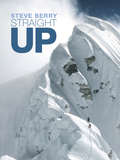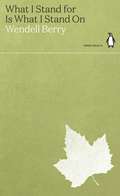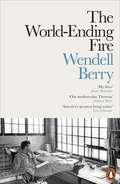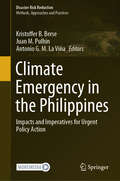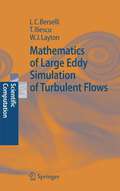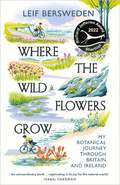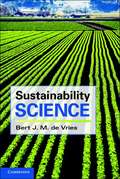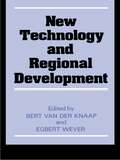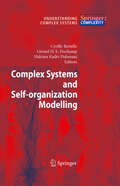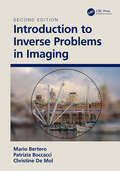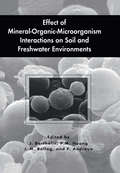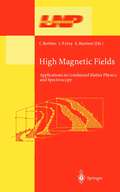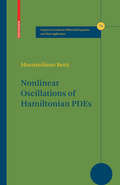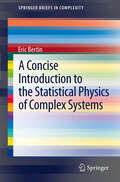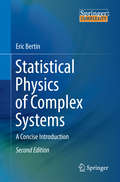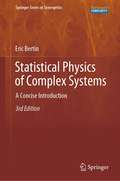- Table View
- List View
The Shaping of Us: How Everyday Spaces Structure our Lives, Behaviour, and Well-Being
by Lily Bernheimer"You are going to be transported by what Bernheimer has to say. You'll make different decisions and figure out how your brain is working and what should be prioritized in your life" Jo Good, BBC LondonWhat makes everyday spaces work, how do they shape us, and what do they say about us?The spaces we live in - whether public areas, housing, offices, hospitals, or cities - mediate community, creativity, and our very identity, making us who we are. Using insights from environmental psychology, design, and architecture, The Shaping of Us reveals the often imperceptible ways in which our surroundings influence our behaviour.Wide-ranging and global examples cover the differences between personalities and nationalities, explore grass-roots and mainstream efforts to build environments promoting well-being, and look ahead to what will become of us if we don't listen closely to what we know is good for us.You will learn whether you are a natural 'prospector' or 'refuger' in the office environment, what roundabouts and stoplights say about British and American culture, whether you are guilty of NIMBYism or being drawn to 'ruin porn', and how the half-house may be a common sight in the near future.The environments we inhabit define our identities - from the earliest moments of our evolution to the worlds we build around ourselves.
Elektropneumatische und elektrohydraulische Bauelemente in der Mechatronik: Konstruktion von sicherheitsgerichteten Steuerungen für Industrie 4.0
by Herbert BernsteinMit der Entwicklung technischer Produkte sind die Anforderungen an die Industrie 4.0 besonders hoch. Dieses Lehrbuch liefert einen Überblick über die mechanischen und elektrischen Bauelemente, die in elektrohydraulischen und -pneumatischen Maschinen und Anlagen zum Einsatz kommen. Zudem wird auf die elektrische Sicherheitstechnik eingegangen. Ein Einstieg in speicherprogrammierbare Steuerungen und in die dahinterstehende Logik runden das Buch ab. Der elektronische, informationstechnische, mechanische, pneumatische und hydraulische Entwickler erhält somit eine Übersicht für sein praktisches Arbeiten.Die Zielgruppen:Ingenieure, Techniker, Meister und alle, die sich in die Mechatronik einarbeiten müssen Studierende technischer Fachrichtungen.
Poetics of the Earth: Natural History and Human History (Routledge Explorations in Environmental Studies)
by Augustin BerquePoetics of the Earth is a work of environmental philosophy, based on a synthesis of eastern and western thought on natural and human history. It draws on recent biological research to show how the processes of evolution and history both function according to the same principles. Augustin Berque rejects the separation of nature and culture which he believes lies at the root of the environmental crisis. This book proposes a three stage process of "re-worlding" (moving away from the individualized self to become a part of the common world), "re-concretizing" (understanding the meaning and historical development of words and things) and "re-engaging" (reconsidering the relationship between history and subjectivity at every level of being) in order to bring western thought on nature and culture into sustainable harmony and alignment. This book will be of great interest to students and scholars of environmental studies, environmental philosophy, Asian studies and the natural sciences.
Poetics of the Earth: Natural History and Human History (Routledge Explorations in Environmental Studies)
by Augustin BerquePoetics of the Earth is a work of environmental philosophy, based on a synthesis of eastern and western thought on natural and human history. It draws on recent biological research to show how the processes of evolution and history both function according to the same principles. Augustin Berque rejects the separation of nature and culture which he believes lies at the root of the environmental crisis. This book proposes a three stage process of "re-worlding" (moving away from the individualized self to become a part of the common world), "re-concretizing" (understanding the meaning and historical development of words and things) and "re-engaging" (reconsidering the relationship between history and subjectivity at every level of being) in order to bring western thought on nature and culture into sustainable harmony and alignment. This book will be of great interest to students and scholars of environmental studies, environmental philosophy, Asian studies and the natural sciences.
Thinking through Landscape
by Augustin BerqueOur attitude to nature has changed over time. This book explores the historical, literary and philosophical origins of the changes in our attitude to nature that allowed environmental catastrophes to happen.The book presents a philosophical reflection on human societies’ attitude to the environment, informed by the history of the concept of landscape and the role played by the concept of nature in the human imagination. It features a wealth of examples from around the world to help understand the contemporary environmental crisis in the context of both the built and natural environment. Berque locates the start of this change in human labour and urban elites being cut off from nature. Nature became an imaginary construct masking our real interaction with the natural world. He argues that this gave rise to a theoretical and literary appreciation of landscape at the expense of an effective practical engagement with nature. This mindset is a general feature of the world's civilizations, manifested in similar ways in different cultures across Europe, China, North Africa and Australia. Yet this approach did not have disastrous consequences until the advent of western industrialization.As a phenomenological hermeneutics of human societies’ environmental relation to nature, the book draws on Heideggerian ontology and Veblen’s sociology. It provides a powerful distinction between two attitudes to landscape: the tacit knowledge of earlier peoples engaged in creating the landscape through their work - “landscaping thought”- and the explicit theoretical and aesthetic attitudes of modern city dwellers who love nature while belonging to a civilization that destroys the landscape - “landscape thinking”. This book gives a critical survey of landscape thought and theory for students, researchers and anyone interested in human societies’ relation to nature in the fields of landscape studies, environmental philosophy, cultural geography and environmental history.
Thinking through Landscape
by Augustin BerqueOur attitude to nature has changed over time. This book explores the historical, literary and philosophical origins of the changes in our attitude to nature that allowed environmental catastrophes to happen.The book presents a philosophical reflection on human societies’ attitude to the environment, informed by the history of the concept of landscape and the role played by the concept of nature in the human imagination. It features a wealth of examples from around the world to help understand the contemporary environmental crisis in the context of both the built and natural environment. Berque locates the start of this change in human labour and urban elites being cut off from nature. Nature became an imaginary construct masking our real interaction with the natural world. He argues that this gave rise to a theoretical and literary appreciation of landscape at the expense of an effective practical engagement with nature. This mindset is a general feature of the world's civilizations, manifested in similar ways in different cultures across Europe, China, North Africa and Australia. Yet this approach did not have disastrous consequences until the advent of western industrialization.As a phenomenological hermeneutics of human societies’ environmental relation to nature, the book draws on Heideggerian ontology and Veblen’s sociology. It provides a powerful distinction between two attitudes to landscape: the tacit knowledge of earlier peoples engaged in creating the landscape through their work - “landscaping thought”- and the explicit theoretical and aesthetic attitudes of modern city dwellers who love nature while belonging to a civilization that destroys the landscape - “landscape thinking”. This book gives a critical survey of landscape thought and theory for students, researchers and anyone interested in human societies’ relation to nature in the fields of landscape studies, environmental philosophy, cultural geography and environmental history.
Noch mehr Sand im Getriebe?: Kommunikations- und Interaktionsprozesse zwischen Landes- und Regionalplanung, Politik und Unternehmen der Gesteinsindustrie (RaumFragen: Stadt – Region – Landschaft)
by Karsten Berr Corinna Jenal Lara Koegst Olaf KühneObwohl mineralische Rohstoffe wie beispielsweise Kies, Sand, Quarz und Naturstein auf vielfältige Weise Grundlagen menschlicher Existenz ermöglichen und garantieren, haben Vorhaben zur Gewinnung mineralischer Rohstoffe vielerorts mit unterschiedlichen Akzeptanzproblemen zu kämpfen. Der planerische Umgang mit Rohstoffsicherung und Rohstoffgewinnung wurde wissenschaftlich bislang hauptsächlich in Bezug auf ökologische oder fachplanerische Problemstellungen, weniger hingegen als teilsystemischer Aspekt in einem soziopolitischen Kontext betrachtet, der durch verstärkten Bürgerprotest und erneuerte Partizipations- und Demokratisierungsbestrebungen gekennzeichnet ist.
Environmental Dilemmas: Ethics and decisions
by R. J. BerryThis is a book by people who have had to make decisions which affect the environment in which we all live, decisions which sometimes affect the quality of life of millions. It is not an academic disquisition on how to approach decision-making. Most of the chapters are written by scientists who have had to take action or make recommendations on environmental matters in situations where the data are incomplete or choices hedged by factors beyond scientific resolution; the result is that they have had to resolve dilemmas about the proper way forward in the matter. My brief to the authors was to describe issues with which they had been personally concerned, rather than simply select from the vast range of envir- mental problems 'out there'. The only exception to this was Andrew Brennan (Chapter 1), who is a professional philosopher; I asked him to say something about the processes and errors indulged by environmental decision-makers. There is some overlap between chapters, but this is not extensive. I have made no attempt to eliminate it, because the aim has been to present personal points of view, not a systematic account of environmental problems. Similarly, there are important topics which are not covered. Indeed, a critic would complain that a book on environmental dilemmas which does not deal directly with the crucial divide between development and conservation is almost wholly irrelevant; from one point of view, it could be condemned as fiddling while Rome burns.
Straight Up: Himalayan Tales of the Unexpected
by Steve BerryBorn in the foothills close to the Himalaya Steve Berry had from an early age an urge to become a traveller, an adventurer, an explorer, and until the age of thirty-eight years he tried hard to satisfy two opposing forces. Half of him wanted to find a satisfactory career path while the other half wanted to be free and specifically explore the Himalaya. In the end he found a compromise to satisfy both needs. In 1987 with his climbing friend Steve Bell he founded Himalayan Kingdoms, a travel company specialising in trekking and expedition holidays. This book is a collection of stories from his early expeditions to the Himalaya prior to 1987. There are tales of encounters with bears, escapes from avalanches, summit successes and failures, love stories mystical connections, Himalayan storms, near death accidents, raw travel across the Indian sub-continent, and grapples with bureaucracy. It is told warts and all. It starts with tales of youthful naivety in the mountains of Himachal Pradesh, progresses to what Steve describes as his best ever adventure, the first British ascent of Nun, 7,135m/23,410ft, in Kashmir, and finishes with the truth of what happened on the failed attempt to climb Bhutan's highest peak, Gangkar Punsum, 7550m/24,770ft. Of Straight Up Steve says: 'I just really wanted people to enjoy reading of our adventures the way they were.'
What I Stand for Is What I Stand On (Green Ideas)
by Wendell BerryIn twenty short books, Penguin brings you the classics of the environmental movement.From the ravages of the global economy to the great pleasures of growing a garden, Wendell Berry's powerful essays represent a heartfelt call for humankind to mend our broken relationship with the earth, and with each other.Over the past 75 years, a new canon has emerged. As life on Earth has become irrevocably altered by humans, visionary thinkers around the world have raised their voices to defend the planet, and affirm our place at the heart of its restoration. Their words have endured through the decades, becoming the classics of a movement. Together, these books show the richness of environmental thought, and point the way to a fairer, saner, greener world.
The World-Ending Fire: The Essential Wendell Berry
by Wendell Berry'He is unlike anybody else writing today ... After Donald Trump's election, we urgently need to rediscover the best of radical America. An essential part of that story is Wendell Berry. Few of us can live, or even aspire to, his kind of life. But nobody can risk ignoring him' Andrew Marr'Wendell Berry is the most important writer and thinker that you have (probably) never heard of. He is an American sage' -James Rebanks, author of The Shepherd's Life Wendell Berry is 'something of an anachronism'. He began his life as the old times and the last of the old-time people were dying out, and continues to this day in the old ways: a team of work horses and a pencil are his preferred working tools. The writings gathered in The World-Ending Fire are the unique product of a life spent farming the fields of rural Kentucky with mules and horses, and of the rich, intimate knowledge of the land cultivated by this work. These are essays written in defiance of the false call to progress, and in defence of the local landscapes that provide our cultural heritage, our history, our home.In a time when our relationship to the natural world is ruled by the violence and greed of unbridled consumerism, Wendell Berry speaks out to defend the land we live on. With grace and conviction, he shows that we simply cannot afford to succumb to the mass-produced madness that drives our global economy. The natural world will not withstand it.Yet he also shares with us a vision of consolation and of hope. We may be locked in an uneven struggle, but we can and must begin to treat our land, our neighbours, and ourselves with respect and care. We must, as Berry urges, abandon arrogance and stand in awe.
Climate Emergency in the Philippines: Impacts and Imperatives for Urgent Policy Action (Disaster Risk Reduction)
by Kristoffer B. Berse Juan M. Pulhin Antonio G. M. La ViñaThis book provides a snapshot of the manifestations of the climate emergency in the Philippines from a wide array of disciplines including physical sciences, social sciences, arts and humanities, management, and law. Researchers and faculties at the University of the Philippines contributed to this compilation, where each chapter provides policymakers and the public a clear picture of why climate change must be confronted with a sense of urgency and near-desperation.Divided into three main parts, the first one zeroes in on climate-vulnerable sectors such as water, food and agriculture, health, and coastal communities in the Philippines to introduce readers to the current pressing impacts of the climate emergency. The second part presents case studies of local experiences from the country’s three island regions, namely, Luzon, Visayas, and Mindanao, and it situates the readers in different environments and contexts. The third part features transdisciplinary responses to the climate emergency, including salient challenges in relation to planning, financing, communication, and education. The concluding chapter highlights eight areas for action to tackle the climate emergency. Each chapter comes with an overview and a Summary for Policymakers, which provides clear guidance for action to be taken by both local and national policymakers.
Mathematics of Large Eddy Simulation of Turbulent Flows (Scientific Computation)
by Luigi Carlo Berselli Traian Iliescu William J. LaytonThe LES-method is rapidly developing in many practical applications in engineering The mathematical background is presented here for the first time in book form by one of the leaders in the field
Where the Wildflowers Grow: My Botanical Journey Through Britain and Ireland
by Leif Bersweden'This bicycle Odyssey of Britain and Ireland's wild flora is joyous, inspirational and beautifully observed.' - Peter Marren, author of After They've Gone'The Wildflowers of Britain have a new champion.' - Lee Schofield, author of Wild Fell'A heart-warming, fascination-inducing read from start to finish.' - Lucy Lapwing'An extraordinary book... captivating in its joy for the natural world.' - Isabel Hardman'When was the last time you stopped and noticed a wild plant?'An intriguing and timely exploration of the importance of Britain and Ireland's plant life.Leif Bersweden has always been fascinated by wild plants. From a young age, his afternoons were spent hunting for and cataloguing the plants in his local area. But it is a landscape that is fast disappearing.Climate change, habitat destruction and declining pollinator populations mean that the future for plant life looks bleaker than ever before. Many of us are also unable to identify, or even notice, the plants that grow around us.Now a botanist, Leif decides to go on a mission, to explore the plants that Britain and Ireland have to offer and to meet those who spend time searching for them. Over the course of a year, Leif goes on a journey around the UK and Ireland, highlighting the unique plants that grow there, their history and the threats that face them. His journey takes him from the Cornish coast to the pine forests of Scotland - even to the streets of London, proving that nature can be found in the most unexpected places. Along the way, Leif highlights the joy and positivity that can be found through understanding nature and why it is so desperately important to protect our wildflowers.
Sustainability Science (PDF)
by Bert J. M. de VriesSustainable development is becoming the guiding principle for the 21st century. It is about quality of life: how to develop it and how to sustain it within planetary boundaries. ‘Sustainability science’ has emerged recently as a new academic discipline and is a growing area of both research and teaching. Sustainability science seeks to: advance basic understanding of the dynamics of human-environment systems and forge bridges between the natural and social sciences and between science and policy; appreciate the variety of perspectives on sustainable development and the variety of contexts for its design, implementation, and evaluation in particular situations. Bert J. M. de Vries has taught a course on sustainability science at Utrecht University for many years, in connection to his research at the Netherlands Environmental Assessment Agency (PBL). This textbook is based on that course. The contents have been rigorously class-tested by his students. The book provides a historical introduction into patterns of past (un)sustainable development and into the emergence of the notion of sustainable development. It systematically surveys the key concepts, models and findings of the various scientific disciplines with respect to the major sustainability issues: energy, nature, agro-food systems, renewable and non-renewable resource systems and economic growth. System analysis and modelling are introduced and used as integrating tools. Stories and worldviews are used throughout the text to connect the quantitative and the qualitative and to offer the reader an understanding of relevant trends and events in context. The reader is explicitly invited to engage at a personal level into the interpretation of what sustainable development means and what implications this has for ideas and actions. Sustainability Science is an ideal textbook for advanced undergraduate and graduate-level courses in sustainable development, environmental science and policy, ecology, conservation, natural resources and geopolitics.
New Technology and Regional Development
by Bert Van Der Knapp Egbert WeverFirst Published in 2004. Routledge is an imprint of Taylor & Francis, an informa company.
Complex Systems and Self-organization Modelling (Understanding Complex Systems)
by Cyrille Bertelle Gérard H. E. Duchamp Hakima Kadri-DahmaniIntroduction to Inverse Problems in Imaging
by M. Bertero P. Boccacci Christine De MolFully updated throughout and with several new chapters, this second edition of Introduction to Inverse Problems in Imaging guides advanced undergraduate and graduate students in physics, computer science, mathematics and engineering through the principles of linear inverse problems, in addition to methods of their approximate solution and their practical applications in imaging. This second edition contains new chapters on edge-preserving and sparsity-enforcing regularization in addition to maximum likelihood methods and Bayesian regularization for Poisson data. The level of mathematical treatment is kept as low as possible to make the book suitable for a wide range of students from different backgrounds, with readers needing just a rudimentary understanding of analysis, geometry, linear algebra, probability theory, and Fourier analysis. The authors concentrate on presenting easily implementable and fast solution algorithms, and this second edition is accompanied by numerical examples throughout. It will provide readers with the appropriate background needed for a clear understanding of the essence of inverse problems (ill-posedness and its cure) and, consequently, for an intelligent assessment of the rapidly growing literature on these problems. Key features: Provides an accessible introduction to the topic while keeping mathematics to a minimum Interdisciplinary topic with growing relevance and wide-ranging applications Accompanied by numerical examples throughout
Introduction to Inverse Problems in Imaging
by M. Bertero P. Boccacci Christine De MolFully updated throughout and with several new chapters, this second edition of Introduction to Inverse Problems in Imaging guides advanced undergraduate and graduate students in physics, computer science, mathematics and engineering through the principles of linear inverse problems, in addition to methods of their approximate solution and their practical applications in imaging. This second edition contains new chapters on edge-preserving and sparsity-enforcing regularization in addition to maximum likelihood methods and Bayesian regularization for Poisson data. The level of mathematical treatment is kept as low as possible to make the book suitable for a wide range of students from different backgrounds, with readers needing just a rudimentary understanding of analysis, geometry, linear algebra, probability theory, and Fourier analysis. The authors concentrate on presenting easily implementable and fast solution algorithms, and this second edition is accompanied by numerical examples throughout. It will provide readers with the appropriate background needed for a clear understanding of the essence of inverse problems (ill-posedness and its cure) and, consequently, for an intelligent assessment of the rapidly growing literature on these problems. Key features: Provides an accessible introduction to the topic while keeping mathematics to a minimum Interdisciplinary topic with growing relevance and wide-ranging applications Accompanied by numerical examples throughout
Effect of Mineral-Organic-Microorganism Interactions on Soil and Freshwater Environments
by J. Berthelin P. M. Huang J. M. Bollag F. AndreuxThe Working Group M.O. (Interactions of soil minerals with organic components and microorganisms) (WGMO) of the International Soil Science Society (ISSS) was founded in 1990 at the 14th World Congress of Soil Science (Kyoto, Japan), with Professor P.M. Huang being the Chairman. Since then, the Working Group M.O. has served as a forum to bring together soil chemists, soil mineralogists, soil microbiologists, soil biochemists, soil physi cists and environmental, ecological, and health scientists. The objective of the Working Group M.O. is to promote research, teaching, and also the exchange of technology concerning the knowledge and the impact of the interactions between minerals-organics and microorganisms on environmental quality, agricultural sustainability, and ecosystem "health". This group is first a scientific group as defined just previously, but it also intends to develop exchange and transfer between scientists and engineers. The first International Meeting organized by Professor P. M. Huang, was held in Edmonton, Canada, in August 1992, where 87 papers were presented by scientists from 20 countries. Following this meeting, a two volume book was edited by P. M. Huang, J. Berthelin, J.-M. Bollag, W. B. McGill, and A. L. Page, entitled "Environmental impact of soil component interaction" : Volume I "Natural and anthropogenic organic-volume II "Metals, other inorganic and microbial activities", and published by c.R.C. Lewis Pub lishers (1995).
High Magnetic Fields: Applications in Condensed Matter Physics and Spectroscopy (Lecture Notes in Physics #595)
by Claude Berthier Laurent P. Levy Gerard MartinezThis book is addressed to all scientists interested in the use of high magnetic ?elds and in the use of high-?eld facilities around the world. In particular it will help young scientists and newcomers to the topic to gain a better understanding in areas such as condensed matter physics, in which the magnetic ?eld plays a key role either as a parameter controlling the Hamiltonian, or as an experimental tool to probe the underlying mechanism. This concerns mostly strongly correlated and (or) low dimensional systems. Rather than covering all these subjects in detail, the philosophy here is to give essential physical concepts in some of the most active ?elds, which have been quickly growing in the last ten to twenty years. Besides its role as a physical parameter in condensed matter physics, a large magnetic ?eld is essential to Electron Paramagentic Resonance (EPR) and Nuclear Magnetic Resonance (NMR) spectroscopies. The state of art of high resolution NMRin liquids and solids and high frequency EPRapplied to ?elds like chemistry and biology are also reviewed in this volume. The ?rst series of chapters is devoted to the integer and the Fractional Qu- tum Hall E?ects (FQHE) in two-dimensional electron systems. C. Glattli brushes an historical background and a comprehensive review of transport phenomena in these systems, including recent developments on the mesoscopic electronic transport at the edges of quantum Hall samples, chiral Luttinger liquids and fractional excitations. R.
Nonlinear Oscillations of Hamiltonian PDEs (Progress in Nonlinear Differential Equations and Their Applications #74)
by Massimiliano BertiMany partial differential equations (PDEs) that arise in physics can be viewed as infinite-dimensional Hamiltonian systems. This monograph presents recent existence results of nonlinear oscillations of Hamiltonian PDEs, particularly of periodic solutions for completely resonant nonlinear wave equations. The text serves as an introduction to research in this fascinating and rapidly growing field. Graduate students and researchers interested in variational techniques and nonlinear analysis applied to Hamiltonian PDEs will find inspiration in the book.
A Concise Introduction to the Statistical Physics of Complex Systems (SpringerBriefs in Complexity)
by Eric BertinThis concise primer (based on lectures given at summer schools on complex systems and on a masters degree course in complex systems modeling) will provide graduate students and newcomers to the field with the basic knowledge of the concepts and methods of statistical physics and its potential for application to interdisciplinary topics. Indeed, in recent years, statistical physics has begun to attract the interest of a broad community of researchers in the field of complex system sciences, ranging from biology to the social sciences, economics and computer science. More generally, a growing number of graduate students and researchers feel the need to learn some basic concepts and questions originating in other disciplines without necessarily having to master all of the corresponding technicalities and jargon. Generally speaking, the goals of statistical physics may be summarized as follows: on the one hand to study systems composed of a large number of interacting ‘entities’, and on the other to predict the macroscopic (or collective) behavior of the system considered from the microscopic laws ruling the dynamics of the individual ‘entities’. These two goals are, to some extent, also shared by what is nowadays called ‘complex systems science’ and for these reasons, systems studied in the framework of statistical physics may be considered as among the simplest examples of complex systems—allowing in addition a rather well developed mathematical treatment.
Statistical Physics of Complex Systems: A Concise Introduction (Springerbriefs In Complexity Ser.)
by Eric BertinThis course-tested primer provides graduate students and non-specialists with a basic understanding of the concepts and methods of statistical physics and demonstrates their wide range of applications to interdisciplinary topics in the field of complex system sciences, including selected aspects of theoretical modeling in biology and the social sciences. Generally speaking, the goals of statistical physics may be summarized as follows: on the one hand to study systems composed of a large number of interacting units, and on the other to predict the macroscopic, collective behavior of the system considered from the perspective of the microscopic laws governing the dynamics of the individual entities. These two goals are essentially also shared by what is now called 'complex systems science,' and as such, systems studied in the framework of statistical physics may be considered to be among the simplest examples of complex systems – while also offering a rather well developed mathematical treatment. The second edition has been significantly revised and expanded, featuring in particular three new chapters addressing non-conserved particles, evolutionary population dynamics, networks, properties of both individual and coupled simple dynamical systems, and convergence theorems, as well as short appendices that offer helpful hints on how to perform simple stochastic simulations in practice. Yet, the original spirit of the book – to remain accessible to a broad, non-specialized readership – has been kept throughout: the format is a set of concise, modular and self-contained topical chapters, avoiding technicalities and jargon as much as possible, and complemented by a wealth of worked-out examples, so as to make this work useful as a self-study text or as textbook for short courses. From the reviews of the first edition: “… a good introduction to basic concepts of statistical physics and complex systems for students and researchers with an interest in complex systems in other fields … .” Georg Hebermehl, Zentralblatt MATH, Vol. 1237, 2012 “… this short text remains very refreshing for the mathematician.” Dimitri Petritis, Mathematical Reviews, Issue 2012k
Statistical Physics of Complex Systems: A Concise Introduction (Springer Series in Synergetics)
by Eric BertinThis third edition of Statistical Physics of Complex Systems has been expanded to provide more examples of applications of concepts and methods from statistical physics to the modeling of complex systems. These include avalanche dynamics in materials, models of social agents like road traffic or wealth repartition, the real space aspects of biological evolution dynamics, propagation phenomena on complex networks, formal neural networks and their connection to constraint satisfaction problems.This course-tested textbook provides graduate students and non-specialists with a basic understanding of the concepts and methods of statistical physics and demonstrates their wide range of applications to interdisciplinary topics in the field of complex system sciences, including selected aspects of theoretical modeling in biology and the social sciences. It covers topics such as non-conserved particles, evolutionary population dynamics, networks, properties of both individual and coupled simple dynamical systems, and convergence theorems, as well as short appendices that offer helpful hints on how to perform simple stochastic simulations in practice. The original spirit of the book is to remain accessible to a broad, non-specialized readership. The format is a set of concise, modular, and self-contained topical chapters, avoiding technicalities and jargon as much as possible, and complemented by a wealth of worked-out examples, so as to make this work useful as a self-study text or as textbook for short courses.
